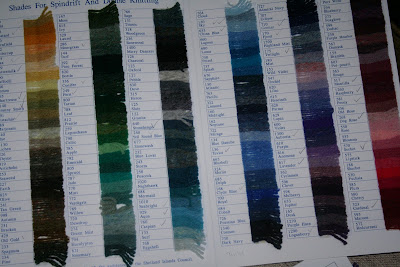Finished, blocked and all.
Learning by doing
One of the reasons I wanted to do this project was to get myself out of my comfort zone and trying some new techniques. Knitting socks had become a bit addictive and I was bored following patterns. The internet is such a brilliant source of help and instruction with new techniques, especially YouTube - it is so much easier to learn practical techniques from actual demonstrations. These are some of the new techniques I mastered.
Steeks
I carried on knitting in the round until the neckline, adding extra stitches at the armholes, which I later cut through and bound, before picking up the stitches for the sleeves. This method, called steeks or steeking in the US, means you can keep on knitting past the armhole.
Purling with stranded knitting is laborious and slows you down considerably. I am not sure this method is called
steeks here in Shetland. I must find out if there is a dialect word.
There are lots of instructions, both written and video, on the net to show you how to do this, if you are thinking of trying it.
Although
cutting through your carefully crafted knitting probably sound scary, there is nothing to fear if you are using the right yarn. It works best with yarn that is very, well, woolly. Shetland wool has all these little stray fibres that hook around each other, especially after they have been washed and dried. They give the garments that lovely 'bloom', make stranded knitting much easier than using 'smooth' yarns and also make unravelling very unlikely.
Short Row Shaping
I used short row shaping to make the cap sleeves and shape the shoulders. This was a new technique for me, though I suppose making a heel in socks is a form of short row shaping. It turned out to be one of these things where you can't see
how it will work, but if you just trust the instructions -
Hey! it works!
It took me a while to work out what to do about the sleeves.
Shetland wool is a joy to knit with, but Kelsey is only three and the gnarly,
yarniness of it is probably not such an attractive feature if it scratches your wee skin. Her mum and I thought it would be best to make it so that it could be worn over a T-shirt, so short sleeves would be better. I couldn't think how the sleeves might look. Then I spotted
Gudrun Johnston's Melby Jumper Dress in
Knit Real Shetland. Cap sleeves work so well with this tunic length.
I-Cord Cast Off
The neckline is formed using a three stitch, I-cord cast off, a technique I learned from one of
Kate Davies' wonderful designs. This is a good example, though, where I put form over function and what looked good just didn't work in practice. Although it gives lovely edge, it is very firm.It would have been such a struggle to get Kelsey's wee noggin through the neck. I didn't want her associating the sweater with pain and discomfort, so out came the scissors again! I cut a little notch and added an i-cord loop and a button. Because this wasn't a planned cut, there are no extra stitches to cut through and bind, so it has formed a little gap and interrupted the pattern.
Purist would shudder, but I want it to be worn and enjoyed....



















